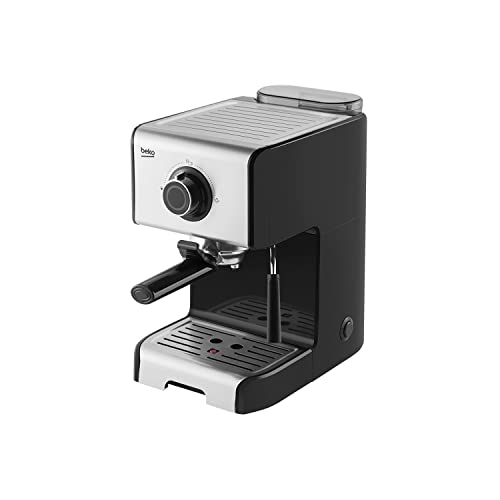How Does Machine Espresso Work?
The machine espresso is made using precise pressure, as well as a filtering technology that is amazing to create the coffee you love. What exactly does it work?
In order to make espresso, hot water is pushed under pressure through finely ground coffee. The process is similar to making drip coffee, but the major difference is in the pressure.
The Head of the Group
As the name suggests, the group head is the place you put your portafilter in when making espresso. It disperses water in the portafilter and regulates the pressure during the extraction. There are many different kinds of group heads, each with their particular advantages and drawbacks. Some focus on temperature stability, some on pre-infusion capabilities, and still others are designed to control the lever. There are also coffee and espresso machine that contain a variety of features, such as the E61 that is the standard choice for many baristas because of its ability to offer multiple benefits in one package.
As you can see in the photo above the group head is made up of many notches in which you can put your portafilter, then twist it by hand to lock it in. There is also a gasket of rubber that is a part of the notches to help create an airtight seal when you insert your portafilter into the machine. The notches allow for precise placement of the portafilter. This is crucial for an efficient extraction.
The group head not only lets you to put in your portafilter easily however it also keeps a constant temperature. It does this by cycling hot water through the brew basket, and around the portafilter, making sure that it is always at the right temperature to extract. It is important to note that even a small variation can mean the difference between a great and a excellent espresso.
The Pump
In contrast to manual piston machines which rely on a lever to pressurize water, Rotary espresso machines rely on motorized pumps to provide the nine atmospheric bars of pressure necessary to extract espresso. The pressure is created by pumping water through a heat exchanger and then through the ground coffee.
Pumps tend to be less expensive and last longer than piston-driven machines. However, both kinds of machines can degrade due to overuse and poor cleaning. They also create mechanical complexity which can result in costly prices for even the most basic models.
Certain espresso machines can eliminate the pump completely and make use of steam pressure to make espresso. This can lead to over-extraction as the boiler that makes steam also causes the water to boil. Additionally these machines are often required to rebuild their pressure between cups, which requires time and energy.
A large majority of espresso machines employ the rotary or vibration pump. A vibration model uses a vibrating disk to generate pressure, while a rotary model pushes hot water through the ground at a rapid speed. Both machines can make great espresso however rotary machines tend to be more stable, quieter and less likely to fail.
The Boiler
The boiler is the part that heats the water to the optimal temperature for extraction. The steam that is produced reaches the portafilter which holds ground espresso beans and is then pumped down into the cup. During this process the steam causes enough pressure to push the grounds of coffee through. This produces a layer of crema on top. This is one of the hallmarks of a great espresso.
There are three kinds of espresso makers, and they differ in the type of pump they use and how hot the coffee is. There are various ways to control the strength of the brew and the size of cup that can be produced by the machine.
The earliest espresso machines were steam types. They employed only one boiler to make both brew and steam, however, the pressure they could generate was low - only two bars of atmospheric pressure at most. The coffee tasted bitter and burnt. The modern espresso machine was designed by the Milanese makers Luigi Bezzerra & Desiderio Pavoni.
The most well-known espresso machine is a semiautomatic one with an electric pump. When people think of espresso machines, they picture these machines. Semi-automatic machines require you to grind and tamp the beans on your own while the pump controls the water flow and pressure. This is a great compromise between the human touch and mechanized consistency.
The Filter
Typically, espresso machines utilize filters that separate the grounds of coffee as they move through the hot water. The filter is also a vital part of the machine's temperature control, since it stops overheating.
Filters also aid in flavor since it allows for a longer flowering period. This helps the beans release their flavors and provides the chance for better extraction.
It is important to remember that even the most efficient filter can produce a bad cup of coffee. The quality of the beans as well as the extraction, remain crucial.

This is where the magic happens. It's what makes espresso taste good. The grouphead (also called the brewhead) is where you put the portafilter, which is the thingy which you put the coffee grounds into, when making espresso.
In an espresso machine that is driven by steam, hot water is heated in an airtight tank to create steam. This then pushes the hot water through the grounds under high pressure. These types of machines tend to be less expensive and easier to maintain than pump-driven models. They are however limited in their ability to create the ideal brewing conditions as they only operate with 1-1.5 bar of pressure. The ideal shot requires 9-10 bars.
In recent years, espresso machines powered by compressed air-pump are becoming increasingly popular. They use an air compressor to force hot water through the grounds and are significantly more portable than steam-driven electric machines.
